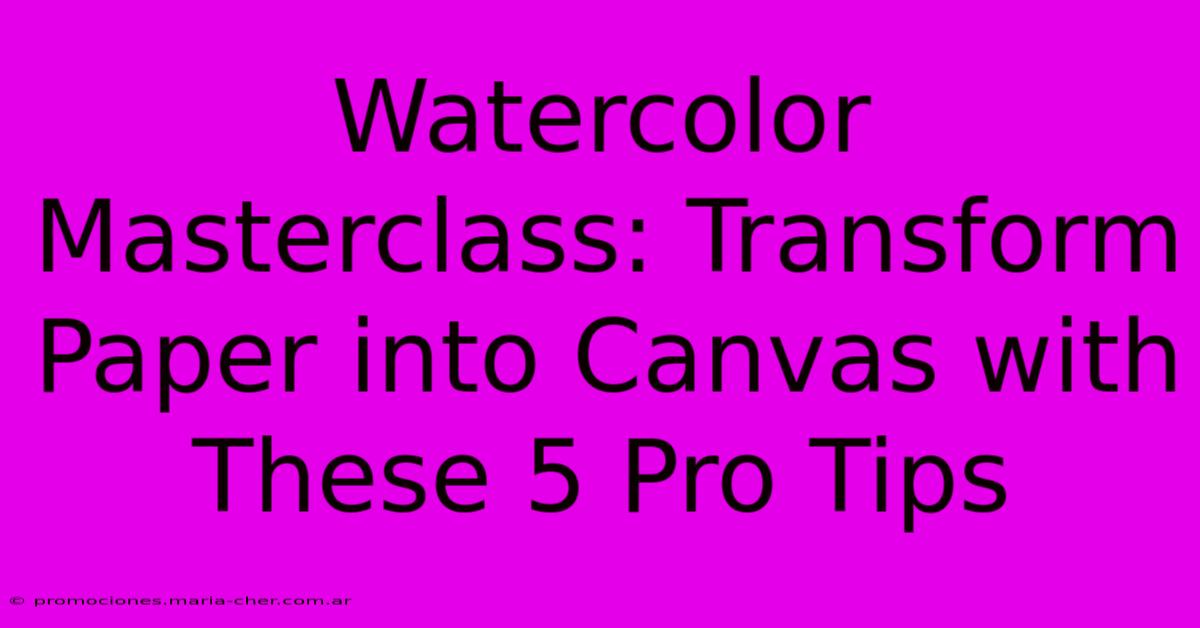Watercolor Masterclass: Transform Paper Into Canvas With These 5 Pro Tips

Table of Contents
Watercolor Masterclass: Transform Paper into Canvas with These 5 Pro Tips
Watercolor painting. The mere thought conjures images of vibrant hues bleeding into one another, delicate washes creating ethereal landscapes, and the unique charm of unpredictable results. But mastering this expressive medium can feel daunting. Fear not, aspiring artists! This masterclass will equip you with five professional tips to transform your paper into a breathtaking watercolor canvas.
1. The Right Paper: Your Foundation for Success
Choosing the right watercolor paper is paramount. Don't skimp on quality! Cheap paper will buckle, pill, and generally ruin your masterpiece before it even begins. Look for 100% cotton paper, which is significantly more absorbent and durable than wood pulp alternatives. Cold-pressed paper offers a slightly textured surface, perfect for a balance of detail and flow. Hot-pressed paper is smoother, ideal for precise details and fine lines. Experiment to find your preferred texture. The weight of the paper is also crucial; 300gsm (grams per square meter) or higher is recommended to prevent warping, especially for multiple washes.
Understanding Paper Weight:
- < 300gsm: Suitable for practice or quick sketches, but prone to buckling.
- 300-600gsm: A great all-around choice for most projects.
- >600gsm: Best for heavy layering and highly saturated colors. More expensive but exceptionally durable.
2. Mastering the Wash: Achieving Smooth Transitions
A beautiful watercolor painting often hinges on the seamless blending of colors. The key? The wet-on-wet technique. This involves applying wet paint to a wet surface, allowing colors to naturally diffuse and create soft, graduated transitions.
Tips for Smooth Washes:
- Pre-wet your paper: Lightly dampen your paper with clean water before applying paint for optimal blending.
- Use plenty of water: Thin your paints with ample water for a smoother flow.
- Tilt your paper: Gently tilt your paper to guide the flow of color, creating natural gradients.
- Lift and blend: Use a clean, damp brush to lift and blend colors, creating soft edges and transitions.
3. Embrace the Negative Space: The Art of Leaving White
Many beginners fill every inch of their paper, resulting in a cluttered and overwhelming piece. Mastering negative space – the areas left unpainted – is key to creating balance and visual interest. Think of the white areas as integral components of your artwork, contributing as much to the overall composition as the painted areas.
Using Negative Space Effectively:
- Plan your composition: Before you start painting, carefully consider where you want your focal points and how negative space will enhance them.
- Use masking fluid: For intricate details or sharp edges, use masking fluid to protect areas you want to remain white.
- Embrace happy accidents: Sometimes, unexpected white spaces add character and spontaneity to a piece.
4. Layering Like a Pro: Building Depth and Richness
Watercolor's magic lies in its ability to create depth and luminosity through layering. Start with light washes and gradually build up intensity. Allow each layer to dry completely before applying the next to prevent muddying your colors.
Layering Techniques:
- Glazing: Applying thin, transparent layers over each other to build depth and richness.
- Lifting: Using a clean, damp brush to remove pigment, creating highlights and texture.
- Scumbling: Applying dry-brush strokes over a dry wash to add texture and interest.
5. Experiment and Embrace Imperfection: Your Unique Style
The beauty of watercolor is its unpredictable nature. Don't be afraid to experiment! Try different techniques, colors, and approaches. Embrace the happy accidents and imperfections; they often add to the unique charm of your work. Most importantly, have fun! The journey of mastering watercolor is as rewarding as the finished product.
By embracing these five pro tips, you'll elevate your watercolor skills, transform your paper into a vibrant canvas, and unlock the full expressive potential of this captivating medium. So grab your brushes, unleash your creativity, and happy painting!

Thank you for visiting our website wich cover about Watercolor Masterclass: Transform Paper Into Canvas With These 5 Pro Tips. We hope the information provided has been useful to you. Feel free to contact us if you have any questions or need further assistance. See you next time and dont miss to bookmark.
Featured Posts
-
A Nation Divided The American Flag With Red Line Unites And Sparks Controversy
Feb 09, 2025
-
Tonsillectomy Price Guide From Budget Friendly To Premium Options
Feb 09, 2025
-
The Art Of Date Sorting In Gmail Declutter And Dominate Your Inbox
Feb 09, 2025
-
Master The Art Of Clear And Concise Formal Texts With Our Ai Powered Tool
Feb 09, 2025
-
Conquer Clutter With Gmail Date Sort Say Goodbye To Messy Emails
Feb 09, 2025
